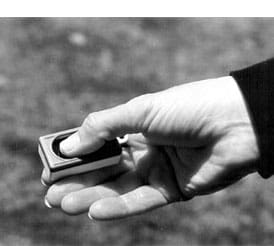A Harness Escape Artist
My dog, Bear, has developed extreme cunning in getting out of whatever device I have on him – buckle collar, body harness (two different styles), Halti head halter – or any combination of these. The only time he was unable to free himself was when the buckle collar was too tight for safety or comfort. Bear’s strategy appears to be to face me, pull backwards, and hop around on his back legs until he pops out of his restraint. Even with the belly band of his harness on tight, he managed to wiggle his elbows through it and pull out backwards.
Also, he’s not easily trainable. He’s smart enough, but he doesn’t really care that much if he pleases us by doing what we say, and he’s not well motivated by food. He’s simply disobedient.
This is getting to be a real problem. Bear gets free so often that my son and I are almost afraid to walk him. As a result, he’s not getting much exercise, and that makes his behavior worse. We’ve been lucky so far that he hasn’t come to grief during his wild getaways, but we can’t go on like this.

-Krista Gimeno
via email
Pat Miller, WDJ’s Dog Training Editor, answers this question for us. Miller, a member of the Association of Pet Dog Trainers, offers private and group dog training classes from her base in Chattanooga, Tennessee.
You are right to be concerned. As you are aware, Bear risks his life every time he escapes, and his lack of cooperation diminishes the quality of the relationship that you and your son have with him.
In fact, the collar problem is just a symptom of the relationship problem. Bear is not motivated to do what you want, and he has discovered a very successful strategy for getting to do what he wants instead. I can give you a solution for the collar-slipping problem, but that won’t solve the relationship problem. That’s a bigger challenge, and one that needs to be addressed in greater detail than we have room for here. I would suggest that you locate a good positive trainer in your area to help you find the key to motivating Bear to do what you ask.
You can find trainers who are Association of Pet Dog Trainer members on the APDT website. Please take time to read the “Guidelines for Choosing a Dog Training Professional” that are posted on the web site. While the APDT promotes and endorses the use of positive training tools and techniques, not all APDT members are committed to positive training to the same degree. Be sure to look for one whose philosophies are aligned with yours before putting Bear’s training in his or her hands.
By the way, it’s a misconception that any dog tries to please us. All dogs try to please themselves. It just so happens that what pleases some dogs also makes us happy. These are the dogs that we call “eager to please.” They are really eager to please themselves, and we are fortunate that their “please factor” is aligned with ours. All dogs are motivated by something, and a good positive trainer will be able to help you identify what Bear’s “somethings” are.
Also, dogs who appear to be indifferent to food sometimes just haven’t found the right food yet. A good positive trainer will have access to a virtual smorgasbord of treat options to experiment with in order to find a food that Bear will work for.
Now, back to the collar. A different brand of head halter might be the answer. Many trainers find the Halti is the easiest of the head halters for dogs to escape from. (See “Proper Use of Head Halters for Leash Training,” WDJ June 2000). The others are not escape-proof, however, particularly for a dog who has found collar-slipping to be a successful behavior strategy.
I would strongly suggest you try the Premier Collar, also known as a martingale or limited slip collar. When properly fitted, this collar will tighten only if Bear tries to back out of it, and only enough to prevent his escape, not enough to choke him or cause damage to his trachea. (See “Looking at Dog Collars as a Restraint Tool,” WDJ, October 2000). This collar should keep Bear safe and secure while you find a trainer to help him (and you!) fix the underlying relationship problem.
A Clicker That’s Not So Loud?
Have you ever heard of a “quiet clicker?” I have been experimenting with all kinds of noisemakers, including the click of a ball-point pen, in hopes of finding something that delivers a well-timed click without making a racket. Many trainers are so enthusiastic about clickers that they use them everywhere, even though they are incredibly disruptive and annoying in many situations. I found something called the Sound Leash on-line but haven’t sent for it yet. It’s battery operated and has a volume control. My dog’s hearing is excellent. When she’s standing next to me, she doesn’t need a click that can be heard a block away. Any ideas?
Miller answers:
Hmm – volume controlled clickers – sounds like a great marketing idea to me! Your experiments with ball point pens are on the right track if you want a quiet clicker. Virtually anything that makes a sharp, abrupt sound can be used as a reward marker. Many trainers use a mouth click, a finger snap or a word – a verbal reward marker – that is reserved, like the clicker, to mean only “the behavior you were doing when you heard the word (or other sound) has earned you a reward.” Some behaviorists theorize that the sharp “Click!” of the clicker is more effective than a word, because it reaches a part of the brain that directly reacts to the sound, rather than having to be filtered and interpreted first.

Also, because the clicker (or some other mechanical sound) always sounds exactly the same, it is a more consistent signal than a word, whose sound can vary depending on your mood, tone of voice, or health. I teach my dogs both a Click! and the word “Yes!” so I can use one or the other, depending on the circumstances.
There are cheap plastic frog clickers that make a softer click, available from mail-order places like the Oriental Trading Company. It can still be a pretty annoying sound, however.
The easiest way to get a soft clicker is to take a regular box clicker and place strips of white adhesive tape over the dot on the metal side of the box. (This handy tip comes from legendary clicker-trainers Bob and Marian Bailey. See “Training Other Species to be a Better Dog Trainer,” WDJ December 1998.) The more tape strips you place over the dot, the more the sound is muted. We use this to desensitize dogs who are fearful of the clicker, by starting with a very soft Click! and gradually removing pieces of tape until it is full strength. But if you wanted to leave the tape on and have a permanently muted clicker, you certainly could!
My Dogs Are “Undressing” Each Other
I hope you can help me with a small but strange problem: I have two Labs who refuse to wear collars. It’s not that they struggle to get out of them; it’s that they have learned that they can take turns chewing each others’ collars off! Needless to say, I have gone through a small fortune in nylon and leather collars.
I now remove the collars when they are left alone. Unfortunately, this action leaves me nowhere to attach their dog licenses or identification tags. I also don’t want to use choke collars for fear they could get snagged on something and do as their name implies.
I’m hoping you may have some recommendations on chew-proof collars or suggestions on how to correct this behavior. By the way, I’ve tried soaking the collars in everything I can think of that will leave a bad taste in their mouths. They seem to appreciate the additional flavoring!
Pat Miller writes:
Clicks to you for being aware of and concerned about the dangers of keeping your dogs without their identification on at all times. You do have a dilemma, don’t you? We can address it a couple of different ways. You could have your dogs tattooed and/or microchipped as identification insurance – not a bad idea even for dogs who don’t chew their collars off, since collars can be removed by other means. (See “Microchip Your Dog to Get Him Home Safe,” WDJ November 1998). These are not perfect I.D. solutions either, but every little bit helps…
A training solution is probably not the answer. Since the behavior happens in your absence, it would be very difficult to come up with a positive approach to preventing the undesirable behavior and rewarding a desirable alternative. You say you have used every taste aversion you can think of. If that means home remedies, you might try the commercial preparations like Bitter Apple. If you’ve tried those to no avail, talk to your veterinarian’s staff. They may have access to veterinary products that are used to prevent dogs from chewing on bandages, products that are significantly more bitter and bad tasting than Bitter Apple.
Actually, your chew-proof collar question made me think of a whole new application for a collar that I previously had no earthly use for. You know those ugly leather spike collars with the metal studs that stick out from the collar, most often seen on Pit Bulls and Rottweilers? Might be worth a try! I would test it for short absences at first, to make sure your dogs don’t ignore the pain and cut their mouths up on the spikes. They are Labs, after all, and tend to have a high pain threshold so they can run through the briars and retrieve fallen ducks from ice-cold lakes.
The other management options are separating them when you’re gone, which I doubt would make anyone very happy, or putting them in doggie daycare, where they can be more closely supervised during the day.





